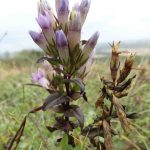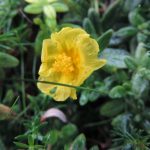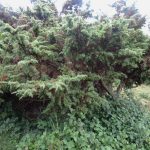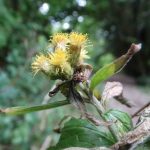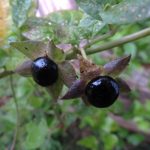Watlington Hill has been a favourite destination of the Society for many years because of the abundance of interesting chalk plants in this National Trust reserve, which tend to be at their best at the end of the summer. No wonder that 14 keen members and friends came to the walk led by Michael Keith-Lucas despite the forecast of heavy rain. Fortunately, the first half an hour of our walk was dry and we admired the flowers of Wild Parsnip Pastinaca sativa, Marjoram Origanum vulgare, Yellow-wort Blackstonia perfoliata, Eyebright Euphrasia nemorosa, Wild Basil Clinopodium vulgare, Harebell Campanula rotundifolia, Small Scabious Scabiosa columbaria and Stemless Thistle Cirsium acaule. A popular name for the latter plant is Picnic Thistle, as the presence of their leaf rosettes amid the vegetation is not very obvious, but when people sit down on them for their picnic, they will jump up because of the very vicious prickles of the leaves. Common Centaury Centaurium erythraea and Autumn Gentian Gentianella amarella were already in fruit because of the long dry spell. However, by now the rain had started, appreciated by the garden owners, but we would have preferred it to have come a few hours later.
Michael pointed out the vegetation on ant hills, which differs from that of the surrounding area. Wild Thyme Thymus polytrichus tends to grow on the south side of the hills, while Germander Speedwell Veronica chamaedrys and Wild Strawberry Fragaria vesca may be found on the north side; rabbit droppings also tend to be located there. The animals keep the grass down in the meadows and avoid the often strong or bitter tasting herbs such as thyme and gentians, so that they get a chance to flourish. Here and there we saw plants associated with acid soil instead of the alkaline chalk, such as Gorse Ulex europaeus and Heather Calluna vulgaris. These grow in quite deep hollows in the chalk dating from the last glaciation which subsequently filled with sand. Perhaps the botanically best site of the hill is just before it slopes down steeply. Here dozens of the rare Chiltern Gentian Gentianella germanica were in flower and we also discovered many flowering Frog Orchids Coeloglossum viride. Only a few flowers were left of Common Rock-rose Helianthemum nummularium, but there were thousands of fruits, so it must have been a spectacular sight when they were all in flower.
The return journey went through a wood, which sheltered us from the rain. This was dominated by Yew trees Taxus baccata, full of fruits which contain a very toxic seed, although the red aril is not toxic. These trees became established by germinating around bushes of Juniper Juniperus communis which used to grow here and which were avoided by browsing animals. Only a few Junipers are left now, but their dead wood, smelling of freshly sharpened pencils when broken, can still be found around the bases of some of the Yew trees. We also saw some ancient Hazel trees Corylus avellana, Beech Fagus sylvatica and Traveller’s-joy Clematis vitalba in this wood. Some other interesting plants were growing in small meadows between the trees and along the verges, such as Clustered Bellflower Campanula glomerata, Wild Mignonette Reseda lutea, Vervain Verbena officinalis, Ploughman’s-spikenard Inula conyza, White Bryony Bryonia dioica, Black Bryony Tamus communis, Deadly Nightshade Atropa belladonna, Carline Thistle Carlina vulgaris, Chalk Fragrant-orchid Gymnadenia conopsea (in fruit), Burnet-saxifrage Pimpinella saxifraga, Squinancywort Asperula cynanchica and Buckthorn Rhamnus cathartica. Because of the wet weather we saw a splendid slug, Arion ater, but we had seen only a few butterfies, including a Meadow Brown Maniola jartina. A path through the wood flanked with Wall Lettuce Mycelis muralis brought us back to the car park.
Report by Renée Grayer
Pictures by Rob Stallard and Laurie Haseler


